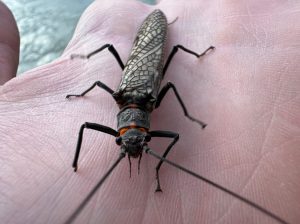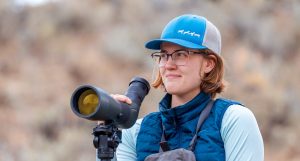Salmonflies: The Biggest of the Little Guys

One day in early to mid-July you might find yourself driving through Yellowstone National Park taking in the amazing scenery all around you. You turn a corner and the beauty of one of the many creeks, streams, and rivers in the park reveals itself. Suddenly, that beauty is interrupted by what looks like a flock of small birds hurtling towards you, and…
SMACK! One finds a nice home in the grill of your car. You get out to look at what the creature was and are faced with Yellowstone’s most charismatic insect: the salmonfly.
Salmonflies are the largest North American member of the order Plecoptera, which are known as stoneflies. They are long, skinny critters with impressive antennae and delicately webbed wings. Some might find their size frightening, but there is actually nothing to worry about! A salmonfly could not bite you even if it tried.
After living as a nymph for three years at the bottom of a stream or river, a salmonfly metamorphizes into adulthood by crawling out of the water, breaking free of its exoskeleton, and drying its wings before taking flight. In their adult form salmonflies eat little if at all, their primary purpose being to breed and lay eggs during their short lifespan.
Thankfully, the presence of salmonflies in a body of water indicates the ecosystem there is very healthy. They are very vulnerable to pollution, and consequently are among the first organisms to die off when toxins enter a river. Giant salmonflies call many streams and rivers in the Greater Yellowstone Ecosystem home as nymphs, and as adults in mid-summer cling to greenery and fill the air with awkward flight. As a bonus, the trout love to eat every salmonfly they can find, which means that the yearly hatch is a great time for fly-fishers!
Next time you drive through the park, keep your eyes to the skies, observe the veritable clouds of stream insects, and thank them for giving us a look into the secret world of water. Count yourself particularly lucky if your visit times out with the annual salmonfly hatch, and you can say you saw the biggest of the little guys!
Content courtesy Yellowstone Wild Guide Aleksa B/ Photos courtesy Aleksa B (top)/ Tyrene R and Emil M (middle)/NPS (bottom)

To learn more about Aleksa and the rest of the Yellowstone Wild team visit our “About Us” webpage.
